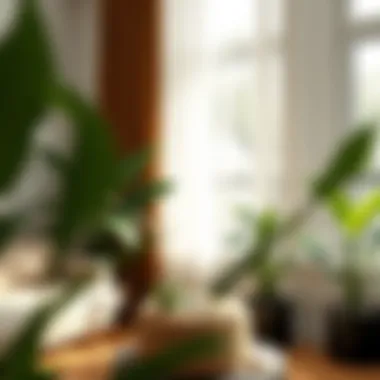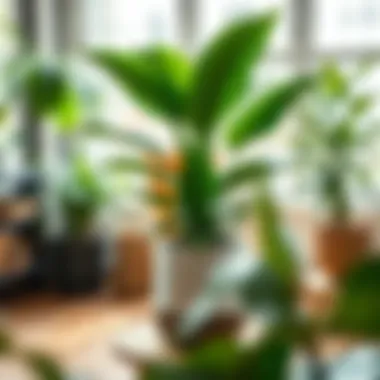Essential Tools for Indoor Plant Care: A Comprehensive Guide


Intro
Summer, fall, winter, or spring, indoor plants can bring any space to life. They cheer up corners, brighten rooms, and even express the personality of a home. To nurture these living companions effectively, understanding the essential tools that make indoor plant care more efficient is crucial. With the right implements, you won't just keep your plants alive; you'll thrive together.
Whether you are a seasoned plant parent or dipping your toes into the world of indoor gardening for the first time, familiarizing yourself with the equipment designed to aid growth and health is an indispensable step. This guide aims to unravel a variety of tools, breaking down their functions, and explaining how they contribute to the overall wellness of your plants.
Through this exploration, we will cover basic staples like pots and watering cans, but also dive into specialized tools that can revolutionize your indoor gardening routine. After all, getting your hands dirty can be quite enjoyable, but doing it with the right equipment is where the magic happens, enhancing both the experience and the results.
As we navigate through this guide, expect to learn something new, whether it’s about the latest watering technology or the humble yet essential trowel. Together, we'll prepare you to create a thriving indoor garden that not only beautifies your space but also nurtures your soul.
Understanding the Basics of Indoor Plant Care
Indoor plant care goes beyond simply watering a few leaves now and then. It forms the cornerstone of a thriving indoor gardening environment. Understanding the basics equips you with the necessary tools and knowledge to nurture your green companions effectively. Fostering a successful indoor plant setup entails recognizing how lighting, humidity, and soil conditions affect each plant's specific needs.
Importance of Proper Tools
Having the right tools is akin to a chef possessing sharp knives and quality pans. If you're going to nurture plants indoors, the tools you select will inevitably dictate your success rate. Appropriate tools enhance the watering process, ensure the soil is aerated, and keep pests at bay. Take pruning shears, for example; they're not just for snip-snap cuts. They allow for precision in grooming your plants, which ultimately contributes to healthier growth.
Using improper tools can lead to unnecessary stress on your plants. Imagine watering with a flimsy cup—it's likely to spill or flood your plants. With a proper watering can, you promote an even distribution of moisture. Sometimes, spending a bit extra on quality tools can save headaches down the road.
Identifying Plant Needs
Every plant has its own personality, if you will, and understanding these nuances is vital for their care. Identifying what a particular plant requires involves observing its leaves, stems, and overall growth. For instance, yellowing leaves might signal overwatering or insufficient sunlight. Conversely, if your plant appears leggy, it may be stretching for light—a clear indicator of the direction you need to head in.
Moreover, consider the plant's origin. A tropical plant will likely crave humidity, while succulents appreciate dry conditions. Each type of plant brings with it specific environmental demands, which can vary drastically. Furthermore, it’s not just about the immediate needs; annual seasonal changes can impact how you should approach care.
Here are key aspects to consider in identifying plant needs:
- Light Exposure: Does your plant enjoy bright, indirect light, or does it prefer the cozy shadows?
- Water Preferences: Is it a thirst-quenching fern or a water-adverse cactus?
- Temperature Tolerance: What range of temperatures does your plant thrive in?
The sooner you can get a handle on these particulars, the smoother your indoor gardening journey will be.
Essential Tools Overview
When delving into the world of indoor gardening, having the right tools is akin to an artist wielding a brush, shaping their canvas. The interplay of different garden tools helps facilitate a nurturing environment for plants, ultimately enabling healthier growth and an aesthetically pleasing home. Knowing which tools to incorporate is key, as it guides the plant care journey from novice to expert.
In this section, we'll explore the essential tools that form the backbone of successful indoor gardening. We’ll consider basic gardening implements, watering devices, and other must-haves you'll encounter along the way. These tools not only make the process smoother but also enhance one's engagement with nature right at home.
Basic Gardening Tools
Basic gardening tools serve as the everyday essentials for plant care. They are tools that you will reach for time and again and thus should be thoughtfully selected for durability and usability.
Hand trowels
When it comes to potting plants or transplanting them into larger containers, hand trowels are indispensable. These small but mighty tools are designed for digging, turning, and smoothing soil, effectively contributing to the overall task of nurturing your plants. Their key characteristic is size – they’re compact enough to navigate tight spaces, yet sturdy enough to handle tough soil.
A notable advantage of hand trowels is their versatility; they can be used for both indoor and outdoor gardening, making them a popular choice for those dabbling in both spheres. However, it's worth remembering that a poorly made trowel can dent, bend, or break, affecting its efficiency.
Pruning shears
Pruning shears, often hailed as lifesavers in the realm of indoor plant care, help maintain a plant's health by removing dead or diseased branches. By promoting air circulation and allowing for more light to reach the center of the plant, these tools contribute to a thriving indoor garden.
A key feature of pruning shears is their sharp blades, which allow for clean cuts, minimizing plant trauma. This action can be essential for some species that benefit significantly from regular pruning. However, the downside to consider is that if not maintained properly, the blades can rust, leading to poor cuts or even damage to the plants.
Gardening gloves
The often-underestimated gardening glove plays a vital role in protecting hands from dirt, thorns, and potentially harmful substances while tending to plants. These gloves not only keep hands clean but also provide a barrier against pests and diseases that can linger in soil.
The primary characteristic of quality gardening gloves is durability; they should withstand the rigors of daily plant care while retaining a comfortable fit. Many gardeners appreciate the variety in materials available, from leather to cotton blends, which cater to different preferences and needs. But, on the flip side, a gloved hand may lose some dexterity, which can be a disadvantage when maneuvering delicate plants.
Watering Tools
Watering is perhaps the most fundamental aspect of plant care, and having the right tools can make a world of difference. Each tool within this category serves a specific purpose, ensuring your plants receive the right amount of moisture.
Watering cans
Watering cans are iconic tools in gardening, available in various shapes, sizes, and materials. Their role in indoor plant care is straightforward yet profound – they provide a controlled means of watering, helping prevent overwatering or under-watering.
One significant aspect of watering cans is their design; many feature a spout that allows for precision watering directly at the base of the plant. Additionally, their portability adds to their appeal, making them easy to use in various settings around the home. However, larger watering cans can become cumbersome, especially when filled with water, potentially leading to spills.
Soil moisture meters
Soil moisture meters have made it easier for gardeners to determine when their plants need watering. These devices measure the moisture level in the soil, providing an accurate reading and helping users avoid the pitfalls of guesswork.
The standout characteristic of moisture meters is their simplicity; most are easy to use with a straightforward interface. This tool takes away the uncertainty in plant care, ensuring that you check the soil's needs before watering. On the downside, while accurate, these meters can be less effective in certain soil types, leading to misleading readings.


Spray bottles
Spray bottles play a crucial role in maintaining humidity and preventing pests. They are perfect for those plants that enjoy a little extra moisture in the air, such as tropical varieties.
Their key characteristic is the ability to mist; this gentle application can be a game-changer for indoor humidity management. Spray bottles are popular not only for hydration but also for cleaning plant leaves from dust or debris. Nevertheless, they can sometimes require frequent refilling, especially if you have a larger collection of plants that crave moisture.
Soil and Fertilization Equipment
Soil and fertilization equipment serves as the backbone of any successful indoor gardening endeavor. Quality soil mixes, containers, and the right tools for mixing and measuring nutrients greatly influence plant health and growth. Without them, even the most robust plants can struggle, making the right choice of equipment crucial for thriving indoor environments.
Types of Pots and Planters
The choice of pots and planters can make or break a plant's development. The right container not only enhances aesthetic appeal but also fulfills essential functions such as drainage, aeration, and nutrient retention.
Clay pots
Clay pots are favored for their porous nature, allowing for proper air circulation and moisture retention. This characteristic helps to prevent overwatering, a common pitfall in indoor gardening. Most gardeners consider clay a reliable option because of its natural properties, making it more environmentally friendly.
One unique feature of clay pots is their ability to absorb excess moisture, which can effectively reduce root rot problems. However, they can be a bit on the heavier side and may crack if not handled carefully. Furthermore, they dry out faster compared to some materials, which may necessitate more frequent watering.
Plastic containers
Plastic containers have gained popularity due to their lightweight and versatile nature. They're often available in various shapes, sizes, and colors, allowing for personalization in indoor design. Plastic is a more affordable option, making it easier to experiment with different plant arrangements without breaking the bank.
These containers generally offer good drainage when holes are present, though they might not provide the insulation benefits of clay pots. A downside is that plastic can retain heat, potentially leading to overheating roots if placed in direct sunlight. Careful positioning is essential, but many find that when used wisely, plastic containers serve their purpose effectively.
Grow bags
Grow bags are an innovative choice that many gardeners swear by. They’re typically made from breathable fabric, promoting healthy root systems through good aeration. This encourages plants to grow vigorously, as roots encounter less resistance while seeking nutrients.
A distinctive feature of grow bags is their portability; they can be moved easily, allowing plants to receive optimal light exposure or to rearrange your indoor landscaping. Despite these benefits, they may require more frequent watering compared to rigid containers due to faster soil drying rates. Still, the advantages of airflow and root health make them a standout choice in soil and fertilization equipment.
Measuring and Mixing Tools
Proper measurement and mixing tools are essential for crafting the right soil mixtures and applying fertilizers accurately. This precision can directly affect plant health and productivity, making it vital to incorporate proper tools into your toolkit.
Measuring spoons
Measuring spoons, often underestimated, play an important role in fertilizing plants correctly. Accurate measurements of nutrients are critical. Over-fertilizing can lead to nutrient burn while under-fertilizing can stunt growth.
A useful aspect of measuring spoons is their variety in sizes, enabling the adjustment of nutrient mixes according to specific plant needs. However, precision is key. Using the wrong measuring tool can lead to disastrous results, so it’s suggested to keep a dedicated set near your gardening supplies.
Mixing bowls
When creating soil mixtures or combining fertilizers, mixing bowls are indispensable. They offer a controlled space to combine various ingredients, ensuring that nutrients are evenly dispersed. A primary advantage is that they come in multiple sizes, accommodating both small and larger quantities of mix.
One consideration is the material; bowls made from non-porous substances are best to prevent moisture absorption. Easy cleanup can sometimes be overlooked as well. Investing in a good set of mixing bowls makes any indoor plant care task simpler.
Spades and trowels for soil preparation
Spades and trowels are classic tools in the realm of indoor gardening. Both play a substantial role in digging, planting, and maintaining soil structure. A spade helps in turning and loosening soil, while a trowel is perfect for precise tasks such as planting seeds or transplanting.
A powerful feature of these tools is their ergonomic designs, which allow for extended use without discomfort. Yet, many novice gardeners mistakenly choose inappropriate sizes, leading to inefficient work. Choosing the right spade or trowel for the job can greatly streamline operations and minimize strain.
In summary, selecting appropriate soil and fertilization equipment enhances your indoor gardening experience. Each tool possesses unique characteristics that, if understood and utilized correctly, pave the way for thriving plants and successful gardening endeavors.
Light Management Tools
Light management is a crucial aspect of indoor plant care. The right lighting determines how well plants perform and thrive within an enclosed space. Plants rely on light for photosynthesis, and in many homes, natural light may not be sufficient to meet the needs of all species. Thus, understanding the various light management tools available can significantly enhance indoor gardening success.
Grow Lights
LED grow lights
LED grow lights represent a significant advancement in indoor gardening technology. Known for their energy efficiency, these lights convert a larger percentage of electricity into usable light for plants. One key characteristic of LED lights is their long lifespan, often lasting up to 50,000 hours. This makes them a cost-effective option over time as they require less frequent replacements.
A unique feature of LED grow lights is their ability to emit a full spectrum of light, tailored specifically for photosynthesis. This not only promotes healthy growth but can also influence flowering and fruiting in plants. While the initial investment in LED technology might be higher than traditional bulbs, their longevity and efficiency usually outweigh the cost concerns. One downside might be heat generation if not properly managed, though most modern options maintain a safe operating temperature.
Fluorescent grow lights
Fluorescent grow lights are a popular choice among indoor gardeners for their versatility and relatively low cost. They come in various styles, such as tube lights or compact fluorescent lamps (CFLs), and are favored for seedlings and low-light plants. The main characteristic that sets fluorescent lights apart is their ability to provide bright light with lower energy consumption than incandescent bulbs.
A standout feature is their cooler operating temperature, which minimizes heat stress on young plants. The advantages of fluorescents include their ability to cover a wide area and customizable lengths. However, they may not be as effective for larger plants requiring intense light, especially during flowering phases. In some cases, growing plants might require a supplementary light source to ensure adequate illumination.
HID lights
High-Intensity Discharge (HID) lights have been a staple choice for serious indoor gardeners, particularly for flowering and fruiting stages. These lights emit a high amount of light and are known for their ability to penetrate deep into plant canopies, making them ideal for larger setups. The main feature of HID lights is their high luminosity, resulting in robust growth and increased yields.


There are two main types of HID lights: Metal Halide (MH) and High-Pressure Sodium (HPS). MH lights are typically used during the vegetative stages of growth, while HPS lights are preferred for flowering due to their red and orange spectrum. A notable disadvantage of HID lights is that they generate considerable heat, which necessitates proper ventilation to prevent plants from overheating. Additionally, they require a ballast to operate, adding to the setup complexity. Nevertheless, for those aiming for high productivity, HID lighting remains a favored choice in many advanced gardening circles.
Light Meters
Light meters are essential tools for monitoring light conditions in an indoor setting. These devices measure light intensity, informing gardeners about the adequacy of light for their plants. Understanding this aspect is vital, as each plant species requires specific light levels to thrive.
Using a light meter can help prevent under or overexposure, saving time and resources. The readings these devices provide assist in determining optimal light setups and also guide adjustments for seasonal changes. They can be invaluable for identifying plant needs and ensure consistent growth.
A well-planned illumination strategy, backed by accurate measurements, assures that plants receive just what they need.
Humidity and Temperature Regulation Tools
Maintaining an appropriate environment for indoor plants is essential, not just for their survival, but for their growth and overall health. Humidity and temperature regulation tools play a key role in this regard, as they help create a stable environment that mimics the plant's natural habitat. Many indoor plants thrive in specific humidity and temperature ranges; too much or too little could spell trouble.
Knowing how to manage these factors can mean the difference between a lush, thriving garden and a sad, wilting mess.
Humidity Meters
Humidity meters, or hygrometers as they are often called, empower plant enthusiasts with crucial data about the moisture levels in the air around their green companions. These devices are simple yet vital, capable of providing precise measurements that inform watering schedules, misting practices, and overall moisture content in the air.
For instance, tropical plants like ferns and orchids generally prefer humidity levels above 50%. Without a humidity meter, you might be guessing, leading to overwatering or underwatering.
Here are a few points to consider when incorporating humidity meters into your indoor gardening toolkit:
- Understanding Your Plants' Needs: Different plants have various requirements for humidity. Familiarize yourself with the preferences of your plants by consulting resources like Wikipedia.
- Location Matters: Place your humidity meter in a central spot of your indoor garden to get a more accurate reading. Areas near windows, doors, or heating vents may give skewed results.
- Digital vs. Analog: Digital meters can provide readings quickly and often show trends over time while analog ones require some interpretation. Choose based on your preference and tech comfort level.
"A humidity meter is like having a weather forecast for your indoor garden."
By considering these aspects, you can ensure the environment aligns with your plants’ preferences, which can promote healthy growth.
Thermometers
Thermometers are another indispensable tool for indoor gardening, often overlooked in favor of more glamorous gadgets. But believe me, they shouldn't take a backseat. Each plant has a preferred temperature range, and being aware of the actual temperature can aid in creating the ideal living conditions for your photosynthetic friends.
They help detect those subtle shifts in temperature that may occur throughout the day or night, affecting your plants’ well-being. For example, if the temperature dips too low during nighttime, it might shock sensitive species like succulents or cacti.
When incorporating a thermometer into your plant care routine, consider the following:
- Types of Thermometers: There are simple mercury thermometers and high-tech digital ones. The latter typically comes with added features, such as humidity reading and memory function.
- Placement: Like humidity meters, thermometers should not be placed near heat sources (like heat vents) or drafty windows that could mislead the readings. Position them at the height of your plants for the most indicative results.
- Know Your Range: Familiarize yourself with the temperature ranges for your specific plants. Tropical species often require warmer conditions, while succulents generally thrive in warmer, dry air.
Appropriate temperature control can dramatically improve plant performance, especially in small indoor spaces where air circulation can be limited.
In summary, investing in humidity and temperature regulation tools like humidity meters and thermometers isn’t just recommended—it’s a necessity for those looking to cultivate a thriving indoor garden. With these instruments, you’ll gain the insights needed to tailor the environment precisely to your plants’ liking.
Maintenance and Care Tools
Taking care of indoor plants involves more than just watering and sunlight. Maintenance and care tools play a vital role in ensuring that your plants thrive. These tools help you maintain cleanliness and proper pest management within your indoor garden.
With proper maintenance tools at hand, not only can you contribute to a healthier environment for your plants, but you can also prevent diseases and plant stress. It’s essential to understand the specific tools available and how they can aid in your gardening tasks.
Cleaning and Sanitation Tools
Keeping your plants free of dust and potential pathogens is crucial. This is where cleaning and sanitation tools come in, assisting you in maintaining a hygienic space for your plants.
Soft brushes
Soft brushes are essential in the gardener's toolbox for various reasons. These brushes come equipped with soft bristles that can delicately remove dust and debris from leaf surfaces without causing any harm to the plant. One of the key characteristics that make soft brushes a popular choice is their gentle nature. They are especially effective for plants with delicate leaves, like orchids or ferns, where rough handling can lead to damage.
Their unique feature lies in their ability to reach into crevices and remove dirt without scratching or harming the foliage. This characteristic promotes healthier leaf respiration, encouraging optimal growth. However, one disadvantage to consider is that they may require more frequent cleaning to avoid transferring dust and dirt between plants.
Microfiber cloths
Microfiber cloths are excellent tools for indoor plant care as they provide an easy and efficient method for cleaning leaves. The key trait of microfiber is its ability to trap dust and dirt effectively due to its dense fibers. Unlike regular cloths, they don’t scratch the plant’s surface, which is a tremendous advantage. When maintaining a plant's cleanliness, moisture can easily be used with microfiber cloths, boosting their cleaning capacity.
Their unique feature is that they are reusable; just toss them in the washing machine after use. That makes them an eco-friendly choice, reducing waste from single-use materials. However, they can be somewhat pricier than regular cloths; investing in good-quality microfiber cloths can save money over time since they endure through several washes.
Pest Management Equipment
Dealing with pests is another layer of indoor gardening that requires proper tools. Having the right pest management equipment can help in preventing infestations before they become a more severe problem.
Insecticidal sprays
Insecticidal sprays are a go-to choice for many indoor gardeners when dealing with pests. They provide quick and effective action to eliminate insects that can harm plants, including aphids or spider mites. A key characteristic of insecticidal sprays is that they often contain ingredients derived from natural sources, making them suitable for maintaining an indoor environment.
Convenience is another advantage, as these sprays can be easily applied directly to the affected plant areas. However, overuse can lead to an imbalance in your indoor ecosystem, potentially harming beneficial insects. Thus, moderation and proper application are advisable while utilizing insecticidal sprays in your indoor gardening efforts.


Sticky traps
Sticky traps serve as an excellent pest management tool for indoor plants, especially for those battling flying insects like gnats. These traps are coated with an adhesive substance, effectively capturing pests when they land on them. One significant characteristic of sticky traps is their simplicity; you place them near plants, and they do the job without the need for spraying.
A unique feature is their visibility; bright colors can attract pests, making them even more effective. Plus, unlike sprays, sticky traps don’t pose any direct harm to your plants or indoor air quality. However, they may not address a severe infestation adequately, as they primarily act as a monitoring tool rather than a comprehensive solution.
Specialized Tools for Advanced Gardening
The world of indoor gardening can stretch beyond pots and watering cans, reaching into advanced techniques that can seem complex at first. However, specialized tools can offer a distinct advantage for those looking to take their indoor gardening to the next level. Whether you're striving for greater yields, healthier plants, or just a smoother gardening experience, these tools are not just luxuries but essential elements of modern gardening practices.
The proper specialized tools can elevate the quality and efficiency of your gardening efforts. For instance, aeroponics and hydroponics kits provide unique growing environments, while reliable plant support structures ensure your leafy friends stand tall. Understanding these tools enables growers to cater to specific plant needs, tailor environments for optimum growth, and troubleshoot potential issues in real-time.
Aeroponics and Hydroponics Kits
Aeroponics and hydroponics present innovative methods of growing plants without traditional soil. In aeroponics, plants derive nutrients from a mist or fog of water mixed with essential nutrients, allowing roots to breathe and absorbing what they need directly. Hydroponics, on the other hand, uses a water-based nutrient solution, promoting quicker growth cycles and higher yields than conventional soil gardening.
These kits come equipped with various components, including reservoirs, pumps, and sometimes integrated grow lights. They mitigate many common gardening problems, such as pests and soil-borne diseases, by eliminating soil entirely. However, they also impose new challenges, such as ensuring the right nutrient mix and maintaining water levels. These systems do require more initial setup and understanding compared to traditional gardening but can pay off splendidly with vibrant and faster-growing plants.
Plant Support Structures
Plants can be prone to flopping or bending, which makes structures that support them invaluable for gardeners aiming for a healthy indoor garden. Two common support structures are trellises and plant stakes, each serving crucial functions in the overall growth process.
Trellises
Trellises are structures that provide vertical support for climbing plants. They can be made from wood, metal, or plastic, and they help in maximizing space by allowing plants to grow upwards rather than outwards. The key characteristic of a trellis is its ability to enhance air circulation around the plants and bring them closer to light sources.
This tool is popular among indoor gardeners who manage plants like tomatoes or peas that naturally want to climb. One unique feature is the latticed design, which can accommodate multiple plants at once. While trellises are advantageous for space-saving, they might come with some downsides; improperly secured plants may still fall, and if neglected, they can become unsightly or even hinder growth when overcrowded.
Plant stakes
Plant stakes are another critical tool in the world of indoor gardening. These are typically long, thin rods made from wood or metal, and they provide necessary support for taller plants that may not be able to sustain their own weight, such as sunflowers or certain houseplants. The primary advantage of plant stakes lies in their simplicity and effectiveness, offering immediate support without complex setups.
Unlike trellises, plant stakes can be used individually for each plant, making them versatile for various plant species and sizes. A notable feature of stakes is that they take up minimal space, making them a great choice for crowded indoor gardens. However, stakes may need to be replaced or adjusted more frequently than trellises, which could lead to taking extra time and effort depending on your plant’s growth rate.
In summary, specialized tools such as aeroponics and hydroponics kits, along with effective plant support structures like trellises and stakes, are fundamental for the serious indoor gardener. They ensure that plants receive optimal conditions for growth while mitigating common gardening issues. By investing time and resources into these specialized tools, you set the stage for a thriving indoor gardening experience.
Choosing the Right Tools for Your Plants
When it comes to indoor plant care, having the right tools can make all the difference. Just like a chef needs sharp knives and quality pans, or a mechanic requires the right wrenches and screwdrivers, gardeners also need their own set of essential tools. Choosing the right tools for your plants is crucial not only for ease of maintenance but also for promoting healthier growth and ensuring a successful indoor gardening experience.
Considering Plant Type and Size
Understanding the specific needs of your plants is key to selecting the appropriate tools. For instance, succulent lovers will often require different implements compared to those nurturing ferns or tropical plants.
- Small vs. Large Plants: If you have small potted plants like ferns or spider plants, you might not need anything more than a small pair of pruning shears and a sprayer. However, larger plants, such as a fiddle-leaf fig or a rubber plant, may necessitate heavier tools like heavier-duty pruning shears and wider watering cans for ease. Additionally, pots should also reflect the size of the plant; you wouldn’t put a big tree in a tiny pot, right?
- Specific Requirements: Some plant types, like orchids, require specific watering techniques and pot types to thrive. For those plants, tools like specialized orchid pots or watering syringes can prevent over-saturation. Knowing whether your plant thrives on wet conditions or prefers the soil to dry out can help decide on tools.
Budget vs. Quality
Now let's chat about another fundamental aspect: the delicate balance between budget and quality. A decent set of tools doesn’t have to break the bank, but quality certainly matters. Here’s what to keep in mind:
- Long-term Investment: You may spot some inexpensive plastic plant care tools during your next shopping spree, but consider how often you'll need to replace them. Investing a bit more in quality tools might seem steep upfront. But they can last, saving you money in the long run. A good pair of pruners can last for years while cheap ones might break within months.
- Doing The Math: For serious plant enthusiasts, understanding how many plants you have and may acquire in the future is also important. Spending a few extra bucks on tools made to last will pay off as your collection grows.
- Try Before You Buy: If you’re unsure about tools' quality, try them out in-store. Feel the weight, check the grip—it all counts when it comes to long hours of tending to your garden. Nobody wants to fuss with a flimsy pair of scissors when cutting back a wilted leaf.
Choosing the right tools is not just a matter of convenience but a necessity. By aligning your tools with the specific needs of your plants and weighing budget against quality, you’ll pave the pathway to a flourishing indoor garden. Flush with vitality, your plants will thank you for providing the right care along the way.
Ending: Building Your Indoor Gardening Kit
Creating your indoor gardening kit isn’t just about throwing a bunch of tools into a bucket and calling it a day. Rather, it’s a thoughtful process that considers your specific gardening style, the types of plants you prefer, and even the space you have available. The right tools can not only help you nurture your plants but can also make your gardening experience more enjoyable and productive.
Importance of Tailoring Your Kit
One size does not fit all when it comes to indoor gardening tools. Assessing your personal needs is crucial for a successful gardening journey. For example, if you live in a smaller space, you might want to consider compact, multi-use tools that don't take up much room. On the other hand, if you're diving into hydroponics, you'll require specialized equipment. Tailoring your kit ensures that you aren’t buying fluff, just tools that help you cultivate your green space effectively.
"Investing in the right tools at the outset can save you a world of headaches down the line."
Assessing Personal Needs
Before you dash off to the nearest gardening store or website, take a moment to think about your individual circumstances. This can seem a little daunting, especially if you’re just starting out, but breaking it down can simplify the process.
- Space Availability
- Plant Preferences
- Gardening Experience Level
- Apartments vs. Houses: Understand how much space you can designate for your plants.
- Windowsill vs. Dedicated Shelf: This can influence what types of pots and lighting you need.
- Different plants have distinct needs. Are you going for air-purifying plants such as snake plants or maybe flowering varieties like African violets?
- Research specific needs for watering, light, and feeding.
- Novice or Expert: If you’re just starting, you might need simpler tools compared to someone who’s been at it awhile and can handle intricate equipment.
By assessing these aspects, it simplifies pinpointing which tools will serve you best in your journey.
Organizing and Storing Tools
Keeping your tools organized can save you a heap of time and energy. Picture yourself digging for that one elusive pair of pruning shears while your plant’s leaves droop in despair. An organized toolkit also leads to better care of those tools, extending their lifespan. Here are a few tips for keeping things tidy:
- Tool Chest or Caddy: Investing in a designated space for your tools keeps them accessible and contained. A portable caddy can move from plant to plant with you.
- Labeling: If you've got a collection of pots, soil types, or fertilizers, a simple labeling system can save frustration in your busy gardening hours.
- Dry Storage: Ensure tools are dried regularly to avoid rust and decay, especially for metal tools like spades and trowels.
In the end, an organized kit doesn’t just make your tasks easier, it sets the stage for better plant care, maximizing your efforts and rewards. And remember, happy gardening begins with a well-equipped gardener.















